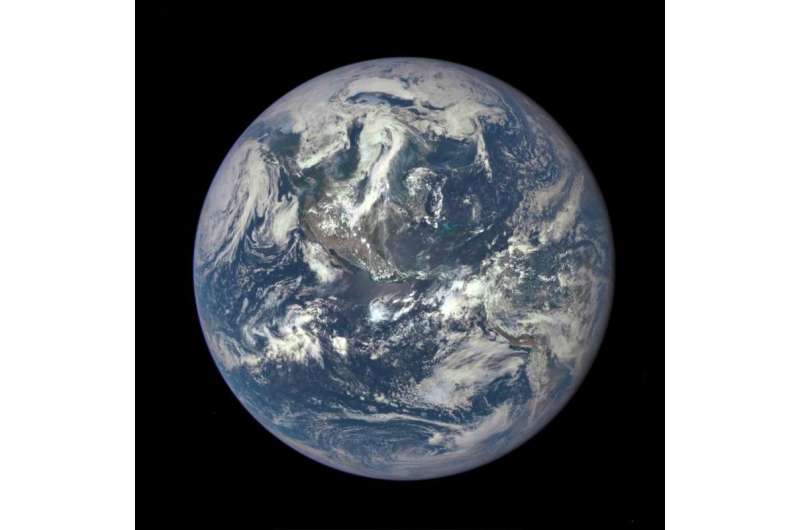Earth observations show how nitrogen may be detected on exoplanets, aiding search for life

Observations of nitrogen in Earth's atmosphere by a NASA spacecraft 17 million miles away are giving astronomers fresh clues to how that gas might reveal itself on faraway planets, thus aiding in the search for life.
Finding and measuring nitrogen in the atmosphere of an exoplanet—one outside our solar system—can be crucial to determining if that world might be habitable. That's because nitrogen can provide clues to surface pressure. If nitrogen is found to be abundant in a planet's atmosphere, that world almost certainly has the right pressure to keep liquid water stable on its surface. Liquid water is one of the prerequisites for life.
Should life truly exist on an exoplanet, detecting nitrogen as well as oxygen could help astronomers verify the oxygen's biological origin by ruling out certain ways oxygen can be produced abiotically, or through means other than life.
The trouble is, nitrogen is hard to spot from afar. It's often called an "invisible gas" because it has few light-altering features in visible or infrared light that would make it easy to detect. The best way to detect nitrogen in a distant atmosphere is to measure nitrogen molecules colliding with each other. The resulting, instantaneously brief "collisional pairs" create a unique and discernable spectroscopic signature.
A paper published Aug. 28 in the Astrophysical Journal by University of Washington astronomy doctoral student and lead author Edward Schwieterman, together with astronomy professor Victoria Meadows and co-authors, shows that a future large telescope could detect this unusual signature in the atmospheres of terrestrial, or rocky planets, given the right instrumentation.
The researchers used three-dimensional planet-modeling data from the UW-based Virtual Planetary Laboratory—of which Meadows is principal investigator—to simulate how the signature of nitrogen molecule collisions might appear in the Earth's atmosphere, and compared this simulated data to real observations of the Earth by NASA's unmanned Deep Impact Flyby spacecraft, launched in 2005.
The craft undertook a revised mission, called EPOXI, which included observation and characterization of the Earth as if it were an exoplanet. By comparing the real data from the EPOXI mission and the simulated data from Virtual Planetary Laboratory models, the authors were able to confirm the signatures of nitrogen collisions in our own atmosphere, and that they would be visible to a distant observer.
"One of the main messages of the Virtual Planetary Laboratory is that you always need validation of an idea—a proof of concept—before you can extrapolate your knowledge to studying a potentially Earth-like exoplanet," Schwieterman said. "That's why studying the Earth as an exoplanet is so important—we were able to validate that nitrogen produces an impact on the spectrum of our own planet as seen by a distant spacecraft. This tells us it's something worth looking for elsewhere."
This confirmation in hand, the researchers used a suite of Virtual Planetary Laboratory models that simulated the appearance of planets beyond the solar system bearing varying amounts of nitrogen in their atmospheres.
The detection of nitrogen will help astronomers characterize the atmospheres of potentially habitable planets and determine the likelihood of oxygen production by nonliving processes, the researchers write.
"One of the interesting results from our study is that, basically, if there's enough nitrogen to detect at all, you've confirmed that the surface pressure is sufficient for liquid water, for a very wide range of surface temperatures," Schwieterman said.
More information: "Detecting and Constraining N2 Abundances in Planetary Atmospheres Using Collisional Pairs." 2015 ApJ 810 57. DOI: 10.1088/0004-637X/810/1/57
Journal information: Astrophysical Journal
Provided by University of Washington





















